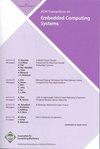A Constructive State-based Semantics and Interpreter for a Synchronous Data-flow Language with State Machines
IF 2.6
3区 计算机科学
Q2 COMPUTER SCIENCE, HARDWARE & ARCHITECTURE
引用次数: 2
Abstract
Scade is a domain-specific synchronous functional language used to implement safety-critical real-time software for more than twenty years. Two main approaches have been considered for its semantics: (i) an indirect collapsing semantics based on a source-to-source translation of high-level constructs into a data-flow core language whose semantics is precisely specified and is the entry for code generation; a relational synchronous semantics , akin to Esterel, that applies directly to the source. It defines what is a valid synchronous reaction but hides, on purpose, if a semantics exists, is unique and can be computed; hence, it is not executable. This paper presents, for the first time, an executable , state-based semantics for a language that has the key constructs of Scade all together, in particular the arbitrary combination of data-flow equations and hierarchical state machines. It can apply directly to the source language before static checks and compilation steps. It is constructive in the sense that the language in which the semantics is defined is a statically typed functional language with call-by-value and strong normalization, e.g., it is expressible in a proof-assistant where all functions terminate. It leads to a reference, purely functional, interpreter. This semantics is modular and can account for possible errors, allowing to establish what property is ensured by each static verification performed by the compiler. It also clarifies how causality is treated in Scade compared with Esterel. This semantics can serve as an oracle for compiler testing and validation; to prototype novel language constructs before they are implemented, to execute possibly unfinished models or that are correct but rejected by the compiler; to prove the correctness of compilation steps. The semantics given in the paper is implemented as an interpreter in a purely functional style, in OCaml.一种具有状态机的同步数据流语言的基于状态的结构化语义和解释器
Scade是一种特定于领域的同步函数式语言,二十多年来一直用于实现安全关键型实时软件。其语义考虑了两种主要方法:(i)基于高级结构的源到源转换到数据流核心语言的间接折叠语义,其语义是精确指定的,并且是代码生成的入口;一种关系同步语义,类似于Esterel,直接应用于源。它定义了什么是有效的同步反应,但故意隐藏了语义是否存在、是否唯一且可以计算;因此,它是不可执行的。本文首次提出了一种可执行的、基于状态的语义,这种语义包含了Scade的所有关键结构,特别是数据流方程和分层状态机的任意组合。它可以在静态检查和编译步骤之前直接应用于源语言。在定义语义的语言是具有按值调用和强规范化的静态类型函数语言的意义上,它是建设性的,例如,它在所有函数终止的证明辅助中是可表达的。它导致了一个纯功能的引用解释器。这种语义是模块化的,可以解释可能的错误,允许建立由编译器执行的每个静态验证确保的属性。它还澄清了Scade与Esterel相比如何处理因果关系。这个语义可以作为编译器测试和验证的oracle;在实现新的语言结构之前对其进行原型化,执行可能未完成的模型或正确但被编译器拒绝的模型;证明编译步骤的正确性。文中给出的语义是用OCaml实现的纯函数式解释器。
本文章由计算机程序翻译,如有差异,请以英文原文为准。
求助全文
约1分钟内获得全文
求助全文
来源期刊

ACM Transactions on Embedded Computing Systems
工程技术-计算机:软件工程
CiteScore
3.70
自引率
0.00%
发文量
138
审稿时长
6 months
期刊介绍:
The design of embedded computing systems, both the software and hardware, increasingly relies on sophisticated algorithms, analytical models, and methodologies. ACM Transactions on Embedded Computing Systems (TECS) aims to present the leading work relating to the analysis, design, behavior, and experience with embedded computing systems.
 求助内容:
求助内容: 应助结果提醒方式:
应助结果提醒方式:


